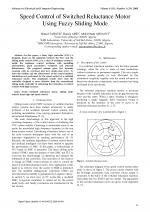| 1/2008 - 4 |
Speed Control of Switched Reluctance Motor Using Fuzzy Sliding ModeTAHOUR, A. |
| View the paper record and citations in |
| Click to see author's profile in |
| Download PDF |
Author keywords
switched reluctance motor, sliding mode control, fuzzy logic and speed control
References keywords
control(8), fuzzy(7), sliding(6), reluctance(6), mode(6), switched(5), systems(4), motor(4), drives(4), design(4)
Blue keywords are present in both the references section and the paper title.
About this article
Date of Publication: 2008-04-02
Volume 8, Issue 1, Year 2008, On page(s): 21 - 25
ISSN: 1582-7445, e-ISSN: 1844-7600
Digital Object Identifier: 10.4316/AECE.2008.01004
Web of Science Accession Number: 000259903500004
SCOPUS ID: 77949389356
Abstract
In this paper, a fuzzy logic controller (FLC) is designed, based on the similarity between the FLC and the sliding mode control (SMC), for a class of nonlinear system to tackle the nonlinear control problems with modelling uncertainties, plant parameters variations and external disturbances. The proposed scheme gives fast dynamic response with no overshoot and zero steady-state error. To show the validity and the effectiveness of the control method, simulations are performed for the speed control of a switched reluctance motor. The simulation results show that the controller designed is more effective than the conventional sliding mode controller in enhancing the robustness of control systems with high accuracy. |
| References | | | Cited By «-- Click to see who has cited this paper |
| [1] T. J. E. Miller, "Brushless-permanent-magnetic and reluctance motor drives", Oxford Science Publication, 1989.
[2] R. Krishnan, "Switched reluctance motor drives modeling, simulation, analysis, design and applications", CRC Press, 2001. [CrossRef] [SCOPUS Times Cited 196] [3] V. Utkin, J. Guldner, J. Shi, "Sliding mode control in electromechanical systems", Taylor and Francis, 1999. [4] V. I. Utkin, "Sliding mode control design principles and applications to electric drives", IEEE Trans. Industrial Electronics, Vol. 40, No. 1, February 1993. [CrossRef] [Web of Science Times Cited 1265] [SCOPUS Times Cited 1742] [5] S. K. Panda and P. K. Dash, "Application of nonlinear control to switched reluctance motors: A feedback linearization approach", Proc. Inst. Elect. Eng., vol. 143, pt. B, no. 5, pp. 371-379, 1996. [CrossRef] [Web of Science Times Cited 57] [SCOPUS Times Cited 110] [6] W. Perruquetti, J. P. Barbot, "Sliding Mode Control In Engineering", Marcel Dekker, 2002. [7] F. Soares and P.J. Costa Branco, "Simulation of a 6/4 Switched Reluctance Motor Based on Matlab/Simulink Environment", IEEE Transactions on Aerospace and Electronic Systems, Vol 37 pp. 989-1009, July 2001. [CrossRef] [Web of Science Times Cited 140] [SCOPUS Times Cited 255] [8] Tzu-Shien Chuang and Charles Pollock, Robust Speed Control of a Switched Reluctance Vector Drive Using Variable Structure Approach, IEEE Transactions On Industrial Electronics, Vol. 44, No. 6, 1997 pp. 800-808 [CrossRef] [Web of Science Times Cited 27] [SCOPUS Times Cited 38] [9] I. Husain, S. Sodhi and M. Ehsani, "A sliding mode observer based controller for switched reluctance motor drives", Conference record of IEEE-IAS annual meeting, Denver, CO, pp. 635-643, 1994. [CrossRef] [10] J. J. E. Slotine , W. Li, "Applied nonlinear control", Prentice Hall, USA, 1998. [11] H. Buhler, "Reglage par mode de glissement", Presses Polytechniques Romandes, Lausanne, 1986. [12] Ji Chang Lo, Ya Hui Kuo, "Decoupled fuzzy sliding mode control", IEEE Trans. on Fuzzy Systems, vol. 6, no. 3, August 1998. [CrossRef] [Web of Science Times Cited 205] [SCOPUS Times Cited 279] [13] W. Kim, J. J. Lee, "Design of a fuzzy controller with fuzzy sliding surface", Fuzzy Sets Syst., vol. 71, 1995, pp. 359-367. [CrossRef] [Web of Science Times Cited 157] [SCOPUS Times Cited 207] [14] G. C. Hwang, S. C. Lin, "A stability approach to fuzzy control design for non linear systems", Fuzzy Sets Syst., vol. 48, 1992, pp. 279-287. [CrossRef] [Web of Science Times Cited 205] [SCOPUS Times Cited 291] Web of Science® Citations for all references: 2,056 TCR SCOPUS® Citations for all references: 3,118 TCR Web of Science® Average Citations per reference: 147 ACR SCOPUS® Average Citations per reference: 223 ACR TCR = Total Citations for References / ACR = Average Citations per Reference We introduced in 2010 - for the first time in scientific publishing, the term "References Weight", as a quantitative indication of the quality ... Read more Citations for references updated on 2024-04-13 00:41 in 54 seconds. Note1: Web of Science® is a registered trademark of Clarivate Analytics. Note2: SCOPUS® is a registered trademark of Elsevier B.V. Disclaimer: All queries to the respective databases were made by using the DOI record of every reference (where available). Due to technical problems beyond our control, the information is not always accurate. Please use the CrossRef link to visit the respective publisher site. |
Faculty of Electrical Engineering and Computer Science
Stefan cel Mare University of Suceava, Romania
All rights reserved: Advances in Electrical and Computer Engineering is a registered trademark of the Stefan cel Mare University of Suceava. No part of this publication may be reproduced, stored in a retrieval system, photocopied, recorded or archived, without the written permission from the Editor. When authors submit their papers for publication, they agree that the copyright for their article be transferred to the Faculty of Electrical Engineering and Computer Science, Stefan cel Mare University of Suceava, Romania, if and only if the articles are accepted for publication. The copyright covers the exclusive rights to reproduce and distribute the article, including reprints and translations.
Permission for other use: The copyright owner's consent does not extend to copying for general distribution, for promotion, for creating new works, or for resale. Specific written permission must be obtained from the Editor for such copying. Direct linking to files hosted on this website is strictly prohibited.
Disclaimer: Whilst every effort is made by the publishers and editorial board to see that no inaccurate or misleading data, opinions or statements appear in this journal, they wish to make it clear that all information and opinions formulated in the articles, as well as linguistic accuracy, are the sole responsibility of the author.





